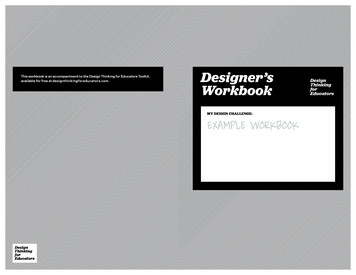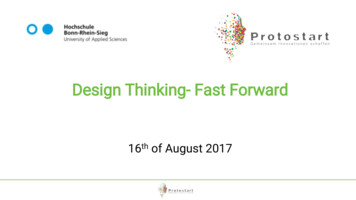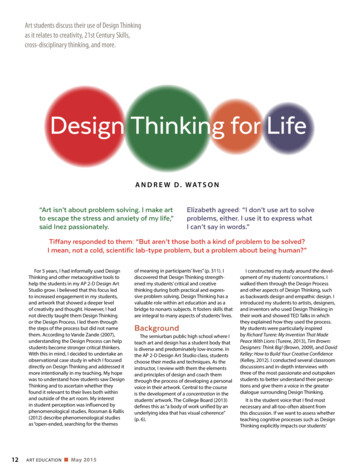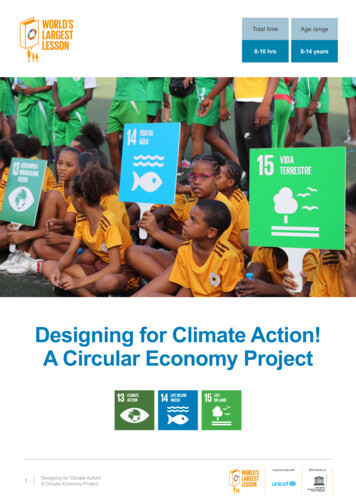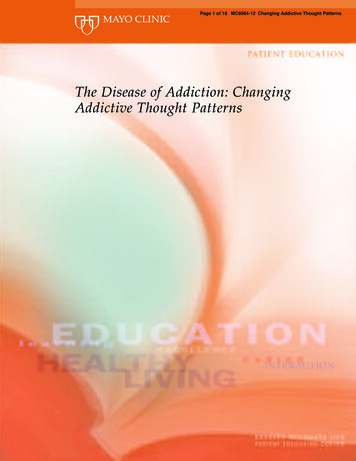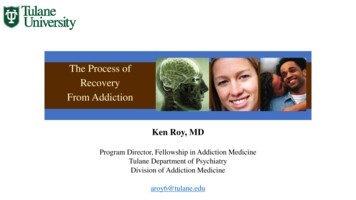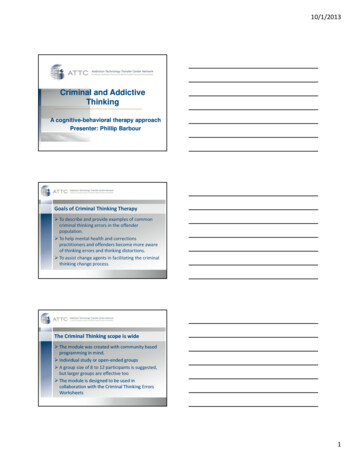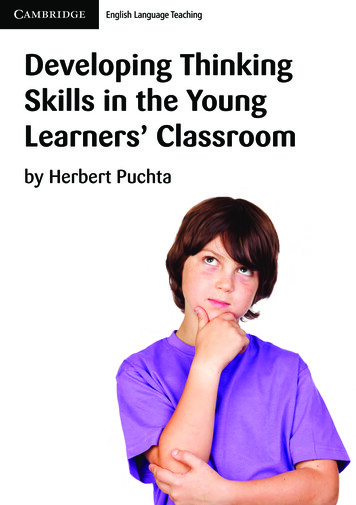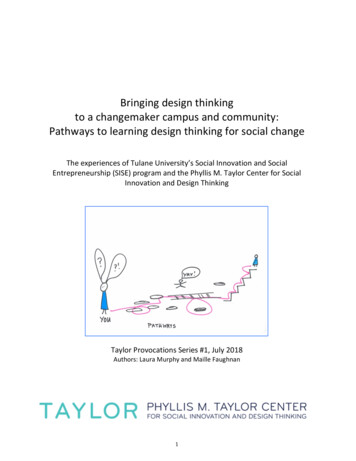
Transcription
Bringing design thinkingto a changemaker campus and community:Pathways to learning design thinking for social changeThe experiences of Tulane University’s Social Innovation and SocialEntrepreneurship (SISE) program and the Phyllis M. Taylor Center for SocialInnovation and Design ThinkingTaylor Provocations Series #1, July 2018Authors: Laura Murphy and Maille Faughnan1
About the Taylor Provocations SeriesThis document is #1 in a series of monographs, working papers, extended essays and other works on socialinnovation and design thinking produced by Taylor staff, fellows, professors, and students. The aim of the series isto provoke thinking and conversation around design thinking, social innovation, changemaking education andrelated themes. Please get in touch if you have an idea for a provocation.About the Taylor CenterThe Phyllis M. Taylor Center for Social Innovation and Design Thinking (TAYLOR) was founded in 2014 at TulaneUniversity with support from local, Louisiana native Phyllis M. Taylor. Thanks to her philanthropy, the centerembraced a range of curricular, co-curricular and other programs. These started as early as 2009, aiming to spreadsocial entrepreneurship and changemaking on campus. Under the Taylor umbrella lie the SISE (social innovation andsocial entrepreneurship) minor, Fast 48 bootcamp, Taylor Your Life courses, the Changemaker Institute, majorSpeaker events, student scholarships, community partnerships, and campus-wide cohorts of Professors of SocialEntrepreneurship. Early on, design thinking was envisioned as an essential skillset for anyone seeking to be achangemaker. As a research university (and with Taylor being a university-wide center) we encourage scholarly andacademic research on design thinking for social impact, which includes critical perspectives, concerns, and limits,from within any and across disciplines.Purpose of this PaperWe believe that design thinking is an essential tool in any changemaker’s toolkit. Such a toolkit is necessary tostprepare graduates—and our campus communities generally—to be better equipped to deal with complex 21century challenges and opportunities. The aims of this document are thus to share our experiences in bringingdesign thinking education to campus and to promote discussion around effective teaching of design thinking topromote changemaking. We describe how, when and why we introduced design thinking at Tulane around 2011/2.We share the learning experiences we offer for varied audiences. We hope to promote constructive dialogue aboutthe purposes of integrating design education within higher education so as to reach the lay designer, i.e., individualsusing design principles but not seeking a professional design career. We are making the case for integrating design“thinking” into contemporary liberal arts undergraduate education and into higher education as both a usefulpedagogy and as a changemaking practice and skillset. We share our experiences, questions, and theoreticalframeworks in the spirit of building a community of transformational practice. We hope this might lead to betterteaching and learning, research and scholarship, and social impact.AcknowledgementsThis monograph builds on hands-on experience of many individuals over several years at Tulane in developing thesocial innovation program, and learning from other campuses, organizations, and educators (by practice andreading and Ashoka U Exchange conferences. We appreciate the numerous students, faculty, staff, and others whohelped launch the Fast 48 bootcamp in 2013 and continue to refine it. We appreciate those who participated in theearly “crash course” workshops to reach beyond classrooms that led to DT & Donuts series. Thanks to several Fast48 community partners: PlayBuild, Grow Dat Youth Farm, and Broadmoor DC. We learned from students, TAs andinstructors in the SISE 3010 design thinking class (including the authors, plus Ann Yoachim, Allison Schiller, andJordan Stewart and TAs); as well as the advanced prototyping classes and Social Entrepreneurship Professors,especially Lars Gilbertson and Marcella del Signore. We noticed the demand for custom facilitation andtraining/instruction from campus and community organizations, which has stretched our thinking to meet newaudiences. Special thanks are owed to our design thinking student fellows Tano Trachtenberg (first cohort), andKristen Hill and Javier Gonzalez (second cohort) who developed worksheets and materials. Third cohort DT fellowsPiper Serra, Sue Choi, John Alexander, and Annika Schneider extended and enriched the design jams and activities.Participants featured in the learning profiles have taught us by asking good questions and taking design thinkinginto their worlds.2
Executive SummaryPurpose and audiences1. This paper, the first in a new “Taylor Provocation” series of monographs, describes the “what,why, how, and for whom” behind design thinking education at Tulane (and in greater NewOrleans and our community).2. Our audiences for this paper are (1) colleagues and students at Tulane and other Ashoka Uchangemaker university campuses who have asked us for our experiences over the years, our (2)affiliated organization and /partners involved in change-making, as well as (3) others interestedin and already teaching design thinking for social impact in higher education.3. We document the specific context, pedagogical approach and “pathways” of learning for ourcommunity. We hope to communicate the value of human-centered design education for thepublic to promote positive social changemaking.4. We aim to stimulate dialogue about how to teach design thinking, why and for whom.Part 1: Background, definitions and context1. Design thinking education started as part of Tulane’s post-Katrina response and university-widesocial innovation and social entrepreneurship (SISE) academic program serving students and thelarger goal of “cultivating changemakers”.2. Changemakers are people with humility, integrity, and knowledge who can use their skills,expertise, gifts, and power in a way that creates positive social change and affirms the humanityof all people. Changemakers have the freedom, confidence and societal support to address anysocial problem and drive change. This definition reflects the mission of Ashoka.org andAshokaU.org, focused on higher education. We teach design thinking (DT) as a human-centeredapproach to understanding problems, working with people, and generating social innovations(novel and relevant solutions to persistent social problems).3. We draw from designers’ toolkits to help people build their empathy, humility, creativeconfidence and other skills to equip changemakers to better address compelling social needswith human-centered approaches (vs. those that might be more technology/gadget-centered orfinancial profit-oriented). Design thinking (DT) refers to this recognized process for problemsolving and a package of human capabilities, mindsets, methods and techniques (see IDEO.organd d.school).4. The social and institutional context for the SISE program and design thinking was thereorganization of Tulane University after Hurricane Katrina around the values of communityengagement and service learning, led by then Tulane president Scott Cowen. The SISE minor is anextension of this commitment to community-engaged learning, research and practice. Goingforward, this context is changing, and the programs will adapt. Social innovation and designthinking training serve others on and off the campus.5. Co-curricular activities at Tulane launched in 2009 and our academic program in 2012. Theoriginal undergraduate course in “Design thinking for collective (social) impact” was first taughtspring 2013 as a required core course in the undergraduate minor in Social Innovation and SocialEntrepreneurship (SISE). The DT course shares the theory and practice of human-centered designthrough readings and hands-on experience with real problems (on or off campus). Other SISEcore courses teach systems-thinking, systems leadership, business thinking, and associated socialinnovation knowledge. The SISE minor is open to any undergraduate student/major from anydiscipline.3
6. Our changemaking education is linked to the Ashoka U network of higher education institutionsinvolved in changemaker education around the world. Tulane is an active and long-standingmember of the Ashoka U Changemaker Campus network.7. Societal problems that we face call for changemakers. According to the Ashoka.org stance of“everyone a changemaker”, the world needs more changemakers, whether social entrepreneurs,social intrapreneurs within large institutions, and/or everyday change-makers stepping up inhomes, communities, and workplaces. Changemakers notice and help address the complex,wicked problems we face. We offer a social innovation “toolkit” for Changemakers to put intopractice.8. Accessibility is a value. Changemaker education, including design thinking– is for everyone.Anyone can and ideally should be able to contribute to society, despite barriers of income,geography and other disparities, and these skills can be relevant to anyone.9. Our theory of change takes an ecosystem approach. Growing changemakers calls for a supportiveecosystem. Changemaking “seeds” are planted and nurtured through inputs of energy,information, and other resources. Connections are reinforced through positive feedback.Relationships are critical to ecosystem resilience. We adapt to reality– the system and actors coevolve. Appreciation for design thinking should thus reach the wider campus and the community,via organizations, partnerships, and internships. Designerly skills and attitudes such as creativity,hopefulness, fail-forward-fast ways of thinking and others are relevant for home, workplace,community, and global social and environmental problems. Addressing one area of skills helpsbuild capacity for working elsewhere.Part II: Learning Pathways, Pedagogy Spirals, and Profiles of Learners1. Taylor Center is a hub for the Tulane campus and community. Taylor Center staff and instructorsoffer curricular, academic, and experiential learning in design thinking. Audiences vary by age,experience, background, institutional affiliation, resources, and prior training. As such, they arefollowing different learning pathways, with various stepping-stones that work for them.2. Current pathways serve undergraduates as SISE minors and non-SISE minors, as well asprofessional graduate students, doctoral students/scholars, Tulane staff, regular faculty,instructors, and administrators. We strive to serve community partners, whether non-profit, forprofit, or governmental.3. Since the center is a university-wide program, we reflect different academic disciplines andtraining, which in turn inform our instructional designs. Our instructors’ disciplines currently spananthropology, architecture, critical theory, education, engineering, environmental studies,international development, planning, public policy, sociology, and urban studies. We furtherstrive to connect design thinking to diverse audiences teaching and working in (for example) arts,ecology, finance, marketing, public health, political economy, and zoonotic diseases.4. Stepping-stones are the formal learning opportunities along these pathways. These includeformal academic courses, short extra-curricular workshops, intensive weekend boot camps, aDesign for America (DfA) chapter, creative life planning elective courses, paid studentfellowships, public speaker events, professional development, and partnerships with classes, andspecial “Taylorized” training/events to reach administrators, teachers, and staff.5. We use an action-oriented pedagogy since people learn design mindsets by doing, and byreflecting. We offer experiences with real-life problems and rely on participatory, learner-ledelements. A spiral of learning recognizes the value in revisiting lessons to deepen learning.6. Several profiles of learners capture different pathways. These represent lay or non-designerpaths to incorporating design mindsets into campus changemaking, civic design, academicresearch, social intrapreneurship, and social ventures.4
Part III. Looking ForwardResearch and scholarship on design thinking for social impact1. We are proponents of design thinking as a creative, hopeful attitude and a set of recognizedpractices, and we are also concerned with the theory and evidence around design thinking forsocial impact. Do the practices and mindsets work to reach social impact? How so, and whataspects of the process work for whom? Who is involved and who is left out? What areunintended consequences?2. We aim to improve our teaching, so we enquire: What are outcomes of design education for layaudiences? How should it be taught best for the audiences we reach, and why? How can design –as intentionally creating new value, social innovations, and/or as problem-solving – be integratedinto campus activities including research, education, and practice?3. We promote reflection among professors, students, and other scholars – anyone concerned withacademic research and knowledge-generation in different forms.a. This spans scientific enquiry and rigorous objective evaluations (on the one hand), tointerpretive enquiry and critical, constructivist perspectives (on the other).b. Scholarly complements to hands-on learning include: independent study, internships,research papers, academic seminars, the “Social Entrepreneurship Professorships” forfaculty, and scholarly research.c. To generate useful knowledge about design thinking as a practical craft for social aims, itis important to understand what “it” is. We encourage scholars and researchers to learnwith us (or elsewhere) about how design thinking works in theory and in practice.Next steps1. Assessment and learning: We seek greater rigor in assessing outcomes. Are we promotingcapacity of individuals to understand, use, and apply (and adapt) design thinking? Is it spreadingas mindsets, and/or practical, discrete techniques? Do our pathways offer adequate training thatour different learners need?2. Training of teams and trainers: One way to spread DT is via training people to teach others totake it to classrooms, workplaces, and organizations. How might we do that better?3. Mainstreaming a culture of design into institutions calls for institutional cultures that support awide range of individuals adopting design mindsets as lay, everyday designers and changemakers.This means people ask “How might we.?” and take time to explore a problem more deeply. Thisallows for teams to manage time in rapid iterative sprints rather than linear, 3-year projectcycles. It means accepting rapid prototyping, embracing messes, uncertainty, and ambiguity.4. Taylor Forward strategy (2017-20) emphasizes values of equity, community, andresearch/scholarship. We will reflect on how current learner pathways and programs supportthese aims, and will seek to fill gaps and find synergies across them.5
Table of ContentsPurpose and Acknowledgements2Executive Summary3Part I: Introduction, Context, and Principles1: Design Thinking and Changemaking Defined2: Tulane and Ashoka U Institutional Context, History, and Background3: Theory of Change-Making, Values, and Principles778Part II: Frameworks, Pathways, and Profiles of Learning4: Different Pathways for Different Learners5: Learning Frameworks and Pedagogy Spirals6: Stepping-Stone Training Experiences7: Profiles of Learners’ Pathways15162027Part III: Looking Ahead8: A Note on Research and Scholarship around Design Thinking9: Next Steps3132Selected References34Appendix: Background to the SISE Minor35List of illustrationsFig 1. Many PathwaysFig 2. Ecosystem ApproachFig 3. Your Pathway?Fig 4. Stanford d.school modesFig 5. IDEO HCD modesFig 6. Inspiration, Ideation, and ImplementationFig 7. Empathy at the center of it allFig 8. Discover, Dream, Do!Fig 9. The spiral of learningFig 10. A Prototyping ParadigmFigure 11. SISE students in action at PlayBuild in New OrleansFigure 12. Scene from the fall 2016 Fast 48 at PlayBuildFig 13. DT and DonutsFig 14. Participants at DT & Donuts with a team design formatList of Text Boxes1. A SISE DT Class At PlayBuild2. A “Taylorized” Learning Partner: the Tulane Advising Center6cover121516171717181820222324252126
Part I: Introduction, Context, and Principles1.Design Thinking (DT) and Changemaking definedDesign thinking is a creative, collaborative, and empathetic approach to problem-solving and valuecreation where we put people (humans) front and center. We see design thinking not as a single skill orpacket of methods, but as a set of mindsets and ways of seeing, doing, and being. Acquiring thesemindsets benefits from practice and reflection, and this document relays how we aim to do that. Thissection offers some background.The approach emerged from various disciplines of design (David Kelley, from product design; Peter Rowe(1987) from architecture) and from within the private sector, in particular for smartphone, mouse, andother digital technologies (Kelley, 2013). Design thinking is recognized as a structured process, languageand set of mindsets or ways of seeing and acting, as well as specific methods and techniques. It isspreading from corporate worlds into domains of non-profit and government action and institutions.Applications of design as “thinking” spread from business innovation for new markets, to social impactsector, aiming to address the larger, ambiguous and complicated challenges of improving health, wellbeing and environmental problems (Brown and Wyatt, 2013).Design thinking can be seen as an intentional process to tackle “wicked” or indeterminate problems(Buchanan, 1992). Design thinking, in concert with systems-led leadership and expert knowledge, canhelp address the “super wicked” global social, environmental, political, and ethical problems. It can helpaddress many societal challenges with deeper empathy, understanding, and problem-(re)definition.Design thinking is widely seen as a useful part of a 21st century toolkit for any effective changemaker.By changemaker, we mean an individual with humility, character, and practical skills to promote positivechange in the world. Changemakers are people with humility, integrity and knowledge who can use theirskills, expertise, gifts, and power in a way that creates positive social change and affirms the humanity ofall people. Changemakers have the freedom, confidence and societal support to address any socialproblem and drive change. This definition reflects the mission of Ashoka.org and AshokaU.org. By toolkit,we mean practical techniques and ways of thinking, doing, being as well as researching, informationprocessing, communicating, generating new ideas, and learning from others. These “tools” cancomplement deep learning in any field and discipline.In this spirit, a primary aim of this document is to promote understanding and constructive dialogueabout why and how to teach design thinking as a toolkit for changemakers in a context of highereducation, and why we seek to serve diverse audiences of lay-designers (vs. professional designeducation). We share our Tulane-specific experiences in our context of post-Katrina New Orleans and aspart of an Ashoka U changemaker network.Another aim is to share our pedagogical practices and experiences in the form of pathways for others,and different stepping stones. We hope to promote a “community of transformational practice” tosupport design thinkers for changemaking. This might be a network of individuals committed to sharinguseful methods, guiding principles, and evaluation tools.As a university-wide center embedded in a research institution, we also seek to promote dialogue,enquiry, evaluation, research and knowledge generation. How can design thinking work best, for whom,7
how and for which types of problems/challenges? How does this process relate to (for example):community development, empowerment, participatory development, policy-change, and rights-basedapproaches?We envision the readers of this paper are: Established change-leaders on campuses: You are curious and interested to learn more about ourexperiences with design thinking as part of changemaking. You can learn how we think about itand talk about it; what it takes to integrate it into programs, campus life, and outreach to reachundergraduate, graduate, and post-grad levels, and for work in different communities. Prospective changemaker campus administrators: You are staff and faculty exploring anddeveloping new changemaking programs, how programs evolve, and how design thinking can fit. Scholars in any discipline: You are seeking to research, communicate, and develop a careerexploring social innovation, design thinking and changemaking, and are wondering what thesefields of action are and where they might fit. Community partners: You are wondering what campuses and staff are talking about and whetherit is useful to your organization. Donors, supporters, thought-leaders: you are interested in trends in higher education in relationto changemaking.A Road Map: The rest of the document is organized into three major parts and additional sub-sections.In Part I, we introduce the recent institutional context of Tulane post-Katrina, the Ashoka U changemakercampus movement, an ecosystem approach and theory of changemaking. Part II describes the conceptof learning pathways (4): how and what we teach as human-centered design to students, staff, facultyand community partners and different frameworks for teaching and learning design thinking (5). Section6 describes several stepping stones: the workshops and classes that offer access to a spiral of learning. Toillustrate these different pathways, we share a few distinct profiles of individual learners’ pathways, fromundergraduate to senior professor, spanning student, staff, and alum. Part II is Looking Ahead. In Section8, we share thoughts on research and scholarship directions we are starting to pursue. Section 9 indicatessome future directions and what might come next at Taylor as part of a changemaker campus, and in thefield. We include key references, details on the SISE minor, and selected photos, sketches to illustrateconcepts and narrative.2.Institutional Context and Changemaker CampusesThis section lays out the larger institutional context of Tulane and trends in higher education ofchangemaking, spanning social innovation, social entrepreneurship and social impact. This field is onearena for promoting design thinking education and supports the trend in training diverse audiences oflearners in design principles and practices (i.e. lay designers, outside of professional design schools).The institutional context for social innovation and design thinking specifically was the reorganization ofTulane University reorganized after Hurricane Katrina around community-engagement and servicelearning. In 2006/7, the president of Tulane made service learning a university-wide requirement for allundergraduate students (at two tiers, freshman (introductory) and upperclassmen, advanced servicelearning). Community engagement generally is embraced and supported under this new mission of socialinnovation and changemaking.8
Several social entrepreneurship initiatives date back to 2008. The office of President Cowen, led bystaffer Stephanie Barksdale, established several programs. They brought major speakers to campus,including Bill Drayton, the founder of Ashoka: innovators for the public. The office devised and launchedprize competitions to motivate student ventures. The university team raised funds to establishindividually endowed, named “Professors of social entrepreneurship”. These support faculty involvementin teaching, research, and service in social innovation and social entrepreneurship (SISE). A team ofstudents drafted a framework curriculum for a major in social entrepreneurship that led to the currentSISE minor, established in 2011/12. The SISE minor program for undergraduate students is thus anextension of a prior commitment to community-engaged and community-based learning, research, andpractice. (See Appendix for more on the founding of the minor and other details of changes since itsinitiation).Changemaker education at Tulane arose after the city-wide devastation of Hurricane Katrina in August2005 and is now embedded in the university. The SISE program and social innovation initiatives wereembraced under the Taylor Center in 2014.The Ashoka U network: from social entrepreneurship to “everyone a changemaker”In 2009, Tulane joined the Ashoka U community, a global network of campuses and a community ofhigher education professionals committed to social entrepreneurship education and “everyone achangemaker”. These are faculty, administrators, and staff on campuses around the world who areseeking to transform higher education and embed social entrepreneurship and social innovationeducation and principles, with the larger goal of cultivating changemakers. These changemakers areoften taken to be the enrolled, tuition-paying students, and yet the concept pertains to other people.Staff, faculty and community partner organizations can also see themselves as changemakers.Ashoka U grew out of Ashoka and its network of over 3000 vetted social entrepreneurs since it wasestablished in the 1980s by founder Bill Drayton. The goal of Ashoka U is to infuse campuses with socialentrepreneurship and social innovation spirit. They do this by supporting faculty, staff, administratorsand students to develop and sustain programs for students (and others) to gain relevant skills andexperience. Ashoka U also aims to shift the institutional norms in higher education and systems (likedegree programs) so as to align better societal needs in addressing complex social and environmentproblems, as well as to meet demand from students for these types of engaged learning experiences.The field of social innovation in higher education has matured and evolved. Much of it is driven byAshoka U, a part of the larger Ashoka movement to promote social innovation and changemaking. (SeeAshokaU.org). The Ashoka U network of changemaker campuses of higher education has grown from ahandful of elite US campuses, including Duke, Brown, Middlebury and Tulane, to over 50 campusesglobally. These span private business schools and community colleges, major public research universitieslike ASU, to alternative colleges (like Watson). Ashoka U runs the annual Exchange Conference, which hasgrown from a few dozen people to about 800 participants each year.From social enterprise to anti-“heropreneurship”Recent keynote presentations at the Exchange articulate trends in social innovation in higher education.An example is the remarks by Ashoka U director Marina Kim at the 2017 Exchange with panelists DanielaPapi-Thornton and others. Speakers emphasize systems thinking, equity, inclusion, and diversity. Insteadof promoting conventional social entrepreneurship models featuring heroic individuals leading highimpact start-ups that scale, speaker call for humbler attitudes and deeper engagement with problems9
(“apprentice with a problem”). They called for intentional and informed attention to equity and socialjustice. They mention creative design “thinking” and doing.This changemaking stance calls for embracing modes of collaborative action (vs. competitions), andecosystem thinking and attention to relationships (not solo efforts). It calls for attention to the validcritiques of societal institutions by social justice advocates and for hearing the voices of people excludedfrom the mainstream and facing discrimination. Recognizing this trend, at Tulane, we aim to shapechangemakers who can work together with others to creatively address complex problems, whereverthey may be. We echo a call for attention to marginalized voices and power structures of privilege thatshape societal inequity and forms of violence.This path might still lead to more conventional social entrepreneurs starting up new ventures that aim toscale up for greater social impact. An example would be Mohammed Yunus and the Grameen Bank forthe field of micro-finance.Or, more likely, we are cultivating the kind of changemakers who function as social intrapreneurs -people who challenge dysfunctional systems and innovate within larger, established institutions ofgovernment, higher education, the non-profit sector and/or private sector. Our changemakers alsomight be scholars and researchers, generating relevant knowledge to support changemaking efforts byasking better questions and learning what works. Finally, they might be donors, helping alignphilanthropic funding, policy and decision-making towards social impact.A liberal arts settingBy liberal arts, we refer to a broad-based university education and community that promotes a spirit ofcuriosity, inquiry, critical thinking, reasoning, participation in civil society, and a lifelong journey oflearning and (re)imagination. Liberal arts education in the classical humanities, natural sciences, andsocial sciences are at the core of the undergraduate campus. A valid goal of liberal arts education is inpromoting informed, aware and humble changemakers who can combine deep disciplinary educationwith attitudes and toolkits for societal problem-solving and genuine community-engagement. Promotingand teaching changemaking as a capacity to design new goods and systems is a valuable function of auniversity. Design thinking can help cultivate these qualities.Going beyond the traditional liberal arts, we also support development of professional and preprofessional skillsets of changemakers. This means complementing degrees such as bachelor ofarchitecture, public health as well as professional graduate degrees in public health, medicine, socialwork, business, and law. Design thinking offers a practical addition to any of these degre
social entrepreneurship) minor, Fast 48 bootcamp, Taylor Your Life courses, the Changemaker Institute, major Speaker events, student scholarships, community partnerships, and campus-wide cohorts of Professors of Social Entrepreneurship. Early on, design thinking was envisioned as an e

